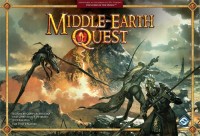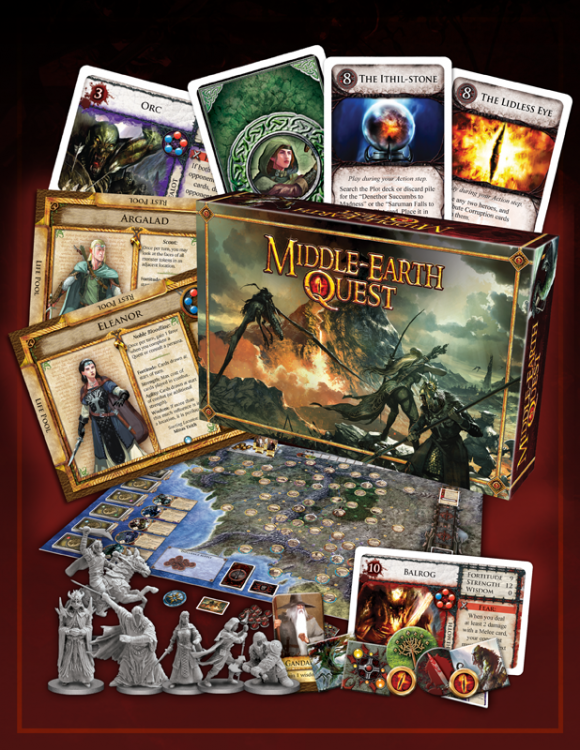
Middle Earth Quest

It is a time of growing darkness and despair. Sauron the Great, the Dark Lord of Mordor, has returned to his ancient fastness of Barad-dûr. From there, his evil and corruption has spread across the lands once more. Alas, in the West, there is little strength left. The Elves have all but abandoned Middle-earth, and the blood of Númenór has run thin; that which remains now dwells in Minas Tirith, or with the lonely rangers that haunt the ruins and wild country of Arnor.
Yet, there is still hope. Gandalf the Grey has learned that the One Ring, the master–ring which Sauron desires and fears above all, is with the hobbit Frodo in the Shire. And there are heroes! Heroes to aid Gandalf in his hunt for the creature Gollum, and in his quest for the lost knowledge of Isildur’s Bane. Heroes, whose strong arms guard the Shire from the enemy. Heroes, who venture into the forests of Ithilien, or even into the Land of Shadow itself, there to disrupt the schemes of Sauron, wherever they may be found.
Middle-earth Quest is set in the seventeen-year period between Bilbo’s birthday party and the Ring’s departure from the Shire, as described in J.R.R. Tolkien’s novel The Lord of the Rings.™
One player takes the role of Sauron, who is attempting to dominate Middle-earth with his nefarious plots and evil minions. Up to three other players take the roles of heroes who must hold the darkness at bay until Gandalf’s plans have matured. To do so, the heroes must embark on dangerous quests and consult with the famous characters of Middle-earth to gain favor and knowledge.
Will you play as Sauron and claim Middle-earth as your own? Or will you play as a hero and stand against the Dark Lord?
The fate of Middle-earth rests in your hands!

User Reviews (4)
Add a Review for "Middle Earth Quest"
You must be logged in to add a review.

This is meant to be a general review covering the basics of the game. This is not meant to be a comprehensive review of all the game mechanics.
Overview
This is a 2-4 player asymmetric area control / hand management game. One player will take on the role of Sauron while the remaining players will play the heroes of Middle Earth. Sauron will use his influence and near-endless supply of monsters and minions in a race against the clock to advance his plots before the free people’s win the game.
The objective of the game for both players is to have their story marker(s) advance up the story track and whoevers marker reaches the end first is the winner.
The heroes have one marker that is advanced 2 spaces at the end of every turn. So for the heroes to win they simply have to hang in the game long enough and they will win by default. The Sauron player has 3 markers and they advance according to the plot cards that he currently has in play. If any one of Sauron’s markers reaches the end of the story track before the heroes (or if all 3 reach a certain position about 2/3 up the story track) then Sauron wins the game.
The core game for the heroes is to traverse the map doing quests and gaining favor in order to discard Sauron’s plot cards.
The core game for Sauron is to keep his plot cards in play by controlling the map using his influence and monsters/minions.
Components
This is definitely a game that is worth all of its asking price. The sculpts for the minions and heroes are incredibly detailed, the markers and tokens (all 235 of them) are all double-sided and made of thick cardboard, and the cards (all 475 of them!) are all sturdy and should easily survive many playthroughs.
The only complaint I have about the game’s components is that the board is split into two halves. To some it may not be a big issue, but personally I found it a bit annoying as sometimes the two halves would shift a bit and the map would not look matched up. Again, not a HUGE issue, but one worth nothing.
Mechanics
At its core the game is very simple. The sauron player has a limited number of actions each turn and may do one of three things.
He may place influence on the map which is used to make locations perilous (Hero draws bad cards when they visit them), and allows him to summon monsters on those locations with his influence.
He may draw shadow cards and plot cards. Shadow cards are just event cards that Sauron can play given he meets their trigger conditions, and plot cards are the cards he plays to move his markers up the story track.
He may also choose an action which allows him to summon monsters, move monsters or minions, or heal minions. Sauron starts the game with 2 minions and unlocks 3 additional minions automatically once a marker has reached a certain place on the story track.
The hero players will draw cards each turn and will use those cards for both travelling and combat.
Each path in the game between any two locations has both an icon and a card cost. The icons (forest, mountain, etc) mean that the hero may discard one card of that type to travel that path, or if the hero chooses he may discard any number of cards equal to the cost and travel along that path.
The heroes discard cards to move, they discard cards to fight, and they discard cards when they take damage. In order to regain the cards they’ve lost they must rest which enables Sauron to automatically move the token that has moved the least up the story track one space up the story track.
For the heroes the game revolves around hand management. Knowing when it is best to fight (almost never), and how to travel the map most efficiently given the cards in their hand.
Combat is simple and involves no dice. Both sides will have a hand of cards and both players will choose a card and put it facedown. Both players then turn their cards faceup and both sides take damage equal to their opponents card’s attack value vs. their card’s defense value. There are also special abilities on most of the cards that may cancel opponent cards, deal extra damage, make the hero play their next card revealed, etc.
Downtime
This is a big deal about games for me so I try to make special note to mention it when I talk about games. This game can suffer greatly from analysis paralysis especially given a new Sauron player. The heroes play is mostly reactionary, just handling the things that Sauron throws at them, with just a dash of preventative measures thrown in. The Sauron player has to make the choice given their current hand of plot cards how to setup the map to best protect them throughout the game. This can sometimes makes the Sauron players turn drag on, and if you are playing with 4 people then there is a lot of downtime between turns for the Sauron player as he has to wait for 3 whole player turns before he can move. If any of these turns involve combat the downtime is increased.
Given a group of experienced players the turns will go FAST. Even combat can be breezed through once both sides have a grasp of the mechanics and strategies. If downtime is a big issue for your group then play the game with 2 or 3.
Summary (Why is it fun?)
This game to me is an amazing mix of strategy, variable player powers, tactics, and just good old fashion luck. Both players have an incredible amount of decision making to do throughout the game, and most games are VERY close. The ending can sometimes be a bit anti-climactic, but the journey itself is a fascinating one. If you’re into highly thematic, strategy, or area control games then this should definitely be in your collection.
This game is not unlike the works of Tolkien that inspired it. It is deep, rich and completely immerses you in the world of Middle Earth but is a bit dense and could scare off those not willing to make a bit of an effort.
One player takes the role of Sauron while 1-3 others act as heroes of Middle Earth striving to stop Sauron’s plots from enveloping the world in darkness. The gigantic and gorgeous game board features a detailed map with interconnected locations.
As Sauron spreads his influence, populates the world with monsters and inflicts perils and corruption onto the players, they act to collect information, meet notable Tolkien characters and thwart Sauron’s plots.
Every side has a secret winning condition – it is selected from five possibilities, making for a tense standoff until the very end as you keep guessing what is it that your enemy is striving for. The variety of victory conditions offer great replay value to the game.
Heroes’ abilities are represented by cards and these cards act as a mix of travel options, combat maneuveres and hit points. These should be spent wisely as resting and recuperating gives Sauron time to advance his plots, which is to be avoided.
The game has several mechanics going, but nothing ever feels out of place as the combat, exploration and travel flows very well. Every rule is logical and once you get into the groove of things the game is quite brisk. You never have down time as each opponent’s action immediately makes you re-evaluate your strategy. Just don’t make an inexperienced player Sauron – that might lead to analysis paralysis.
Combat deserves a separate mention. It is all cards-based, no dice, and provides for fast and very tense experience. A surprising amount of strategy goes into it too, given just how quick it is.
The production values of the game are amazing – all illustrations are of highest quality and all minis are finely sculpted. It really adds to the enjoyment of the game.
The game is not a breeze by any means, but the 3-4 hours playtime on the box seems a tad long – we finished our first game in 2:45.
I highly recommend this game to all Tolkien fans as it brings Middle Earth to life. It is much more than a sum of its parts, resulting in a fantastic experience that makes you want to play again as soon as you’re done. Once you make the initial effort to learn it, the amount of fun you can have with this one is incredible.
This game has a great premise: a race of Middle-earth heroes vs. Sauron. I love the idea, and the components are amazing. But, this game falls victim to the same problem as many FFG big box games: too many different mechanics going on, and none of them quite blending well together. It feel like too many disjointed rules never quite fit; there are too many token and too many phases, and sub-phases. This is the same problem I have with Arkham Horror, Mansions of Madness, Android, and a half dozen other FFG games. Some people love this style; multi-taskers and the like. To me, the game is too much like work, and less like fun. The other drawback is set-up time. Usually everyone has lost interest before we even start.
Again, I love the idea and the components, but it feels less like a free-flowing game, and more like a clumsy sum of it’s parts.
I know that sounds odd but the way they have written the combat system makes this game unique to me . . . wish more games used this method.
The whole game is great to be honest. Many Fantasy Flight Games are on my list !